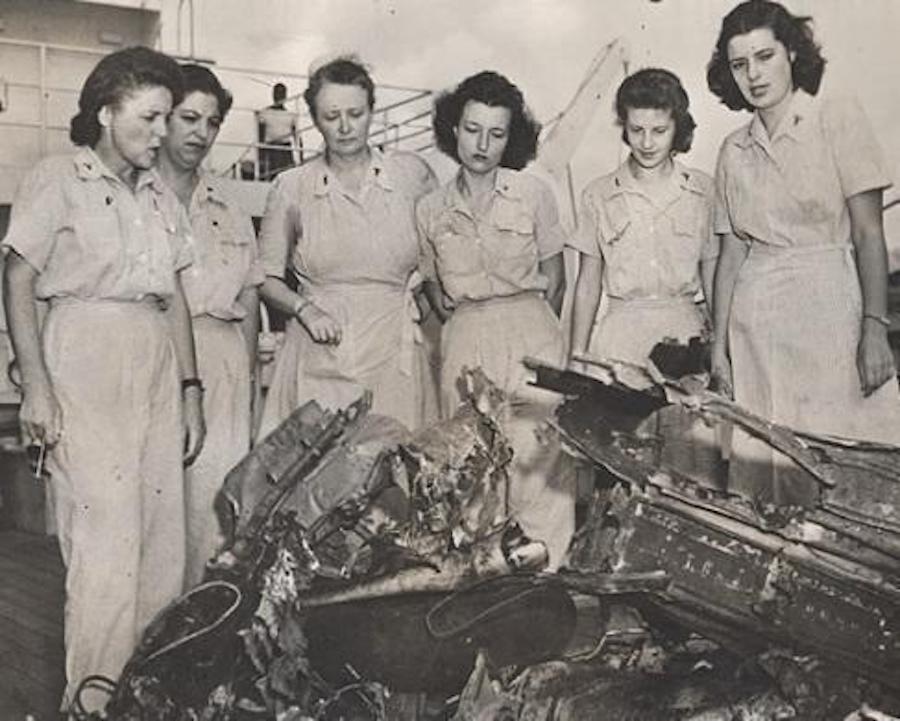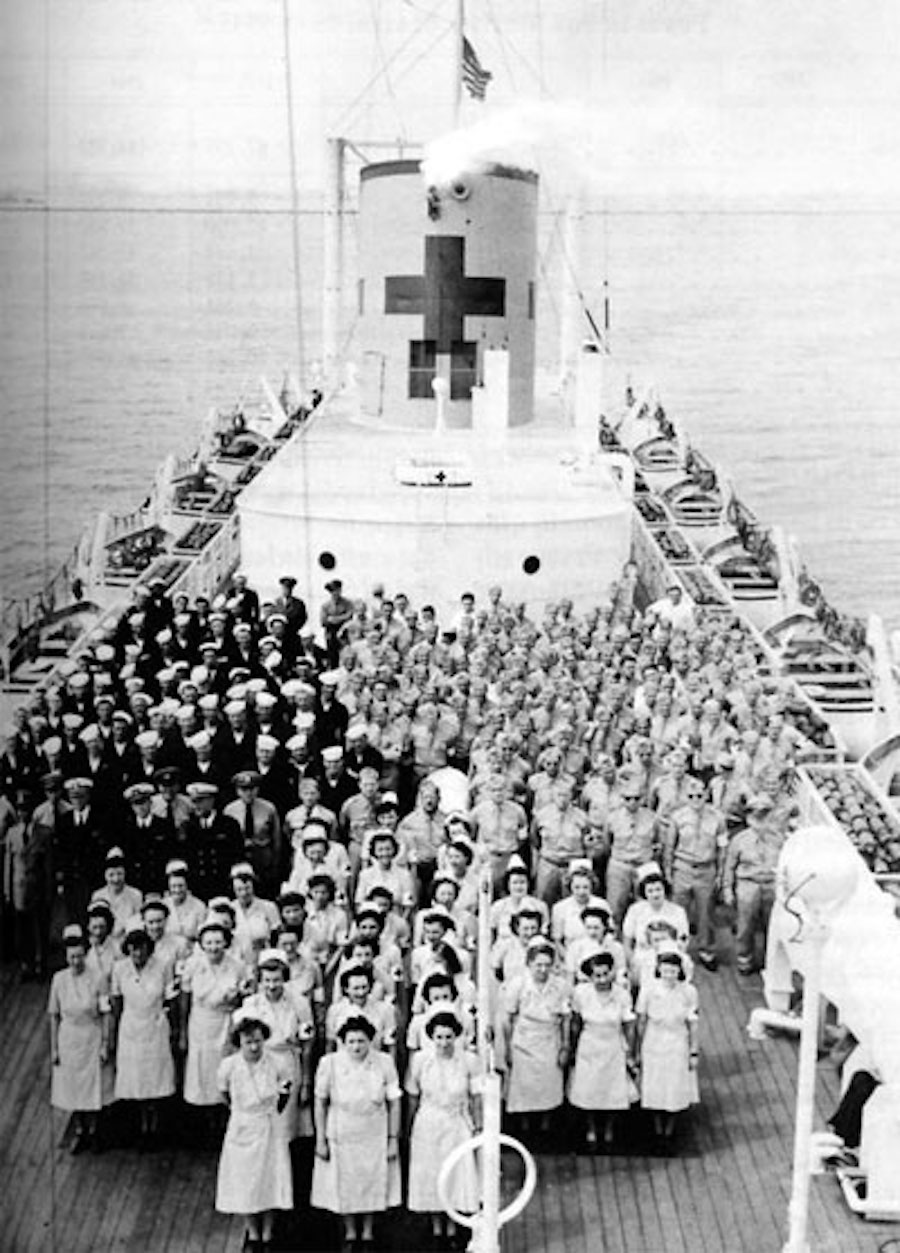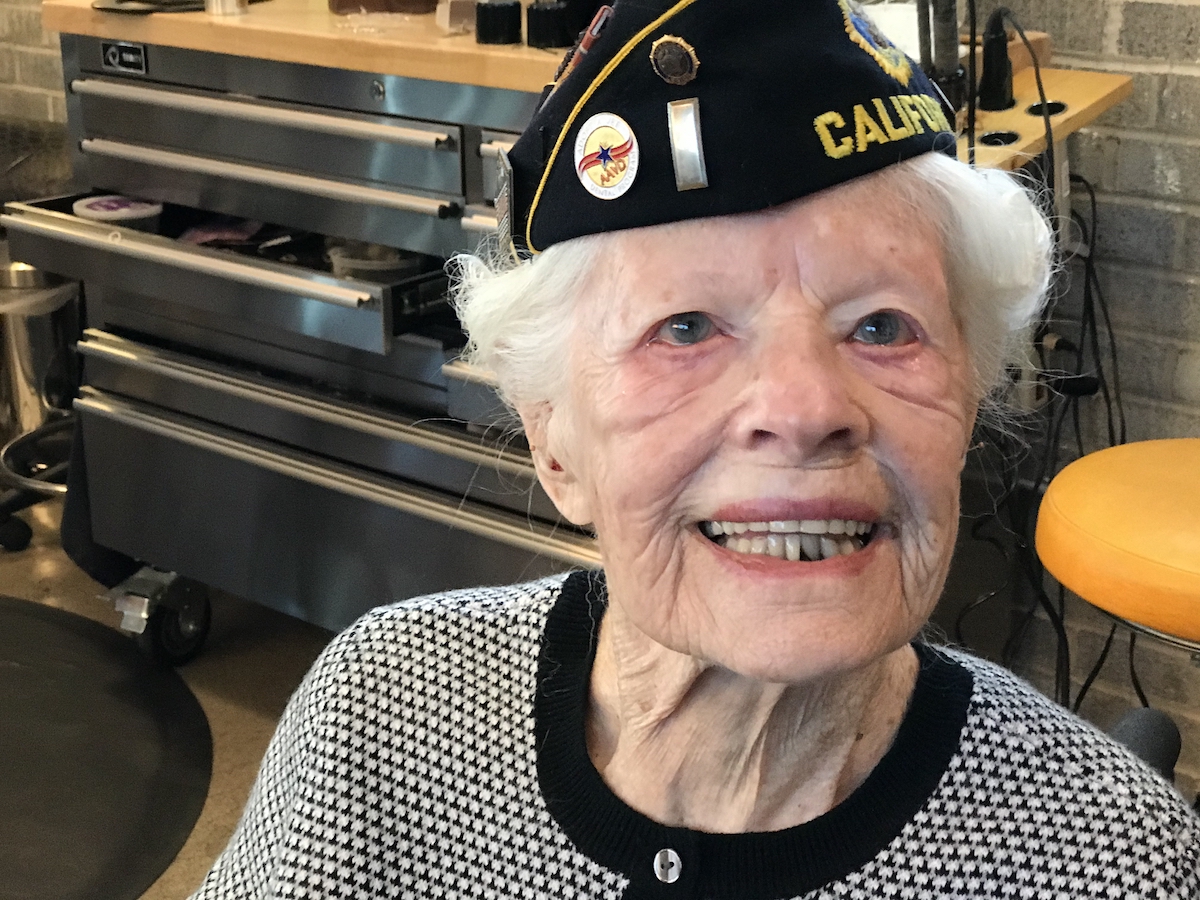The USS Comfort, circa May 29, 1944
The Japanese attack on Pearl Harbor 80 years ago plunged the United States into a war on two fronts. On the following day, Dec. 8, 1942, Congress declared war on Japan.
“I ask that the Congress declare that since the unprovoked and dastardly attack by Japan on Sunday, Dec. 7, 1941, a state of war has existed between the United States and the Japanese empire,” President Franklin Roosevelt told Congress.
After Germany declared war on the United States on Dec. 8, both the Senate and House of Representatives affirmed the country’s resolve and voted to go to war against the Axis powers three days later.
Doris (Gardner) Howard, along with thousands of other men and women, visited a recruiter to enlist. She had plans to join the Army, following in the footsteps of an older brother.
“I had a brother in the service in California and a younger brother soon to be called … drafted,” recalled the 101-year-old Howard, who now lives in Reno.
Not only did Howard’s brothers inspire her about duty to country but also the nurses who worked with her at a hospital in Waukesha, Wis. Because of the fighting in Europe that did not include the United States, Howard said the nurses knew what was occurring there and what could possibly happen in this country. The hospital’s nurses, many of whom were married, felt they would be asked to join the war effort.
“They were crying,” Howard said of her colleagues, remembering their excuses to remain home and wanting the single nurses to volunteer. “I have a husband and children. They knew for a quite a while what was going on with Germany.”
Howard said another nurse, Mary Elizabeth, also had a brother and wanted to follow him into the military.
“It took a long time before we were called for our physicals,” Howard said. “Finally, they sent us to a Navy place in Illinois. After our physicals, the doctors started laughing. I didn’t weigh enough, and Mary was flat-footed. However, we were both accepted.” Courtesy Dorishoward.vet
Courtesy Dorishoward.vet
While in Guam, nurses from the USS Comfort inspect engine wreckage from a kamikaze plane. From left, Mary Carpenter, two nurses who came onboard after the attack, Frances Lajavic, Doris Gardner and Mary Rodden.
Howard entered the Army as a second lieutenant. The Kenosha, Wis., native had previously attended a nursing school in Racine and graduated three years later in 1941. Both Howard and Elizabeth sought overseas service after they enlisted, but instead, they found themselves in Palm, Springs, Calif., where soldiers began their desert training 119 miles to the east of the Blythe Army Air Base (later 4th Air Force) before shipping off to North Africa. The El Mirado Hotel in Palm Springs, where the two nurses were assigned, became the Turney General Hospital.
The sweltering desert heat affected the nurses because the only air conditioner was located at the soda fountain. While in Palm Springs, they also experienced Mother Nature’s fury: an earthquake.
“We had to set up the hospital, arrange the beds and order all the supplies that we might need,” Howard recalled. “I was on the surgical ward for a year. When we came in, it was empty; when we left, every ward was full. Mary and I applied again for overseas service. We received orders in April 1943 to Camp Stoneman. We felt like we were there forever. There were no big hospital ships at that time. They were being built in San Pedro.” Courtesy Dorishoward.vet
Courtesy Dorishoward.vet
The maiden voyage of the hospital ship USS Comfort with its Navy crew and Army Nurse Corps, 1944. Doris Howard is in the first row of nine nurses, far right.
The nurses were assigned to the 521st Medical Hospital Ship Platoon (separate) and sailed with the troops. Howard said they sailed on two ships to and from Australia, the USS Lurine and the USS Monterey, both converted hospital ship that belonged to the Matson Line. On their way home, Howard and Elizabeth sailed through the Panama Canal on their way to the ship’s home port of New York City.
The stay in Gotham was short-lived. They returned to Camp Stoneman via a train to the West Coast with intermittent stops at Harvey Houses for breakfast and dinner. With less than a day remaining on their cross-country rail journey to the Bay Area, they stopped in Reno, the first time Howard visited Nevada’s largest city at the time.
Both women served with each other during the war, both on land and at sea. Now, both women were assigned to the USS Comfort, which headed to New Guinea and twice to Brisbane, Australia. The USS Comfort chugged into enemy waters in late 1944, the first time for both Howard and Elizabeth.
“I have no regrets. I was happy with my life,” Howard said, although she and the other medical personnel on board their ship faced adversity later in the war.
When the USS Comfort sailed into port, the wounded were transferred to the hospital ship and transported to a field hospital. The USS Comfort eventually reached Okinawa, an island 1,300 miles southeast of the Japanese mainland, and dropped anchor to pick up more wounded for the next six days. The ships were ordered to go to blackout.
“They kept bringing us wounded until we were loaded to the point that patients were in the aisles,” Howard said. “I was in the ward that took patients immediately after surgery or as they were being loaded on ship. They would be horribly burned, comatose, or already deceased. It was a hard time.”
Howard remembers the harsh fighting on the island, which historians call the worst during World War II. She and the others felt the bombs drop, while Howard was trying to give shots to the injured every three hours.
 Courtesy Dorishoward.vet
Courtesy Dorishoward.vet
Doris Howard
“There was this poor guy that had part of his face and neck shot off,” pointed out. “They put him right next to the nurse’s station, so we could keep an eye on him. What concerned me was the fact that he needed oxygen. Back then, it came in these large tanks. I worried about how stable the tanks were.”
Nurses and doctors worked 12-hour shifts, and Howard was assigned to the night shift, lights out.
Howard’s most harrowing day aboard the ship occurred six days after D-day in Okinawa. She will never forget April 29. A Japanese kamikaze pilot crashed into the USS Comfort, killing 28 including six nurses and wounding 48. Within minutes, the explosion destroyed the surgery, and two doctors died as did many patients and other medical personnel. The explosion picked up the 85-pound Howard and threw her against the bulkhead, injuring her spine and banging her head hard.
“They sounded the alarm to abandon ship,” she said. “That alarm was deafening, horribly loud. I could just hear the alarm because there was an outlet right in my ward. Then, I didn’t hear anything else until the next morning. I didn’t have an officer or medical man; no one came. They had all been killed. From that point on, we had no surgical officer as we sailed back to the states.”
Seventy-six years later, the carnage from that late April day remains crystal clear for Howard.
“It was really hard,” she said. “We were short six nurses or three wards. Everyone had to double up and keep care of the patients, keeping them alive.”
A moment of silence followed Howard’s thoughts before she resumed.
“Many people, we lost so many people,” she recalled. “We had a first-hand account. War is worse than anything.”
Editor’s note: Doris Howard’s account for this article focused more on her experiences during World War II. Her account plus an interview with the Nevada News Group are the basis for this article to coincide with the 80th anniversary of Pearl Harbor.
••••
THROUGH THEIR EYES
“Through Our Eyes: The Women Veterans Experience,” an exhibit, featuring portraits and stories of 16 veterans, will be on display through December in the Nevada State Museum’s concourse in Carson City.
“Through Our Eyes” debuted in 2018 as part of the Reno is Artown festival; it’s a collaboration with the U.S. Department of Veterans Affairs “My Life, My Story” program, in which VA staff and volunteers conduct interviews with veteran patients and write short narratives of their lives.
The women interviewed for the exhibit were in the VA Sierra Nevada Health Care System. Since its creation, the exhibit has been displayed at the Nevada Legislature, the National Judicial College on the University of Nevada, Reno campus and other locations around the state.
 Courtesy Dorishoward.vet
Courtesy Dorishoward.vet Courtesy Dorishoward.vet
Courtesy Dorishoward.vet Courtesy Dorishoward.vet
Courtesy Dorishoward.vet
Comments
Use the comment form below to begin a discussion about this content.
Sign in to comment